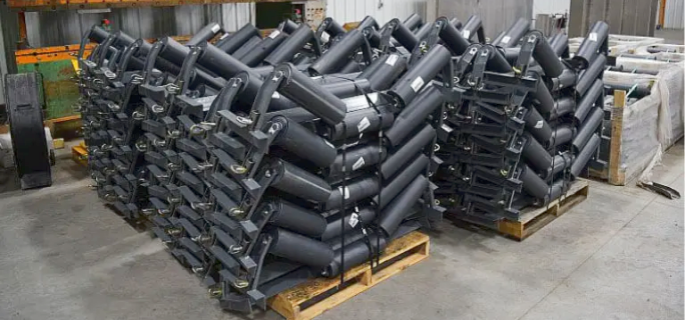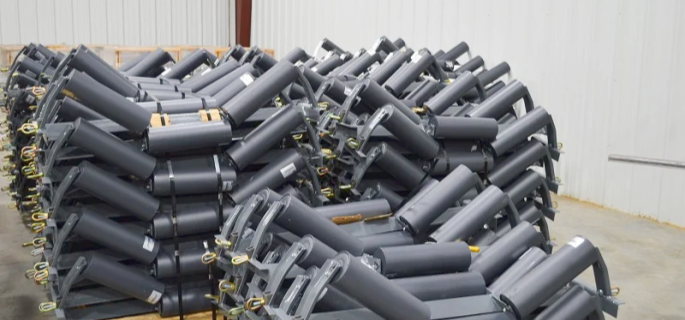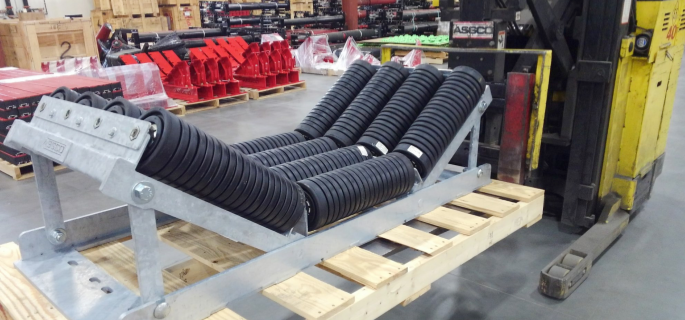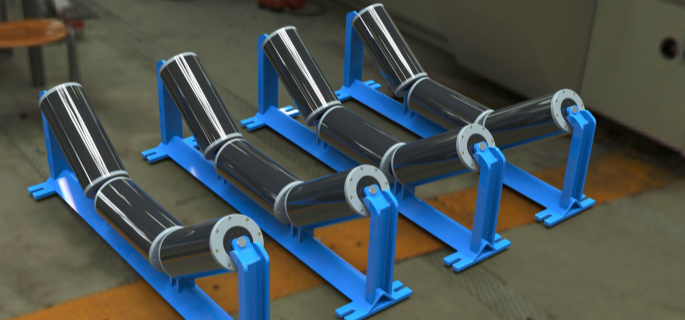Conveyor Roller Belt HS Code: 39269029
Understanding the conveyor roller belt hs code is pivotal for companies involved in international trade, as these codes categorize products for tariffs and statistics. The general conveyor roller belt hs code used globally is 843139 can be used for an export declaration, affects shipment data, import eligibility… Harmonized System (HS) Codes play an essential role in streamlining customs operations and enhancing the accuracy of trade statistics globally. Within India, the Goods and Services Tax (GST) applies standardized taxation based on these HS classifications, directly affecting the financial outcomes for businesses. Conveyor systems, which often incorporate roller belts, are integral to industries like manufacturing, logistics, and warehousing due to their efficiency in moving goods. This introduction outlines the significance of knowing the conveyor roller belt hs code for optimizing trade operations and compliance with tax regulations.
Overview of Conveyor Systems Featuring Conveyor Roller Belt HS Code
Conveyor systems are essential components in various industrial setups, facilitating the movement of goods through automated pathways. Central to these systems are conveyor roller belts, whose specifications are classified under the conveyor roller belt hs code. These systems consist of multiple core components: the roller belts themselves, motor drives, frame structures, and control systems. Roller belts are particularly crucial as they bear the direct burden of transport and are tailored to different operational demands.
For instance, in the packaging industry, conveyor roller belts are used to swiftly transport boxes to different processing stations. In automotive assembly lines, these belts move parts between workstations, enhancing speed and efficiency. Warehouses employ roller conveyors to sort and distribute goods, reducing manual labor and time spent on inventory management. In the food and beverage sector, conveyor systems ensure hygienic and gentle handling of products across bottling and packaging lines.
The versatility of roller conveyor systems is demonstrated by their capacity to handle a variety of loads, adapt to various speeds, and operate in different environmental conditions, from dry warehouses to moisture-rich food processing plants. Each application underscores the necessity of understanding the specific conveyor roller belt hs code related to these systems, ensuring compliance and efficiency in global trade and logistics.
HS Codes and the Conveyor Roller Belt HS Code
Harmonized System (HS) Codes are a globally standardized system of names and numbers used to classify traded products. These codes are essential for international trade, allowing countries to consistently identify goods for taxation, statistics, and regulatory purposes. The conveyor roller belt hs code is particularly significant in the classification of conveyor parts, streamlining the import and export processes by providing a clear description of the goods to customs authorities.
HS Code for Conveyor Roller Belts
Delving into the specifics, the conveyor roller belt hs code helps categorize roller conveyor belts under precise classifications, facilitating smoother trade operations. For example, the general HS code 8428 encompasses various types of conveyors, while the more specific HS code 84283920 applies directly to roller conveyors used in different sectors. Other examples include HS codes for motorized roller belts, used in automated assembly lines, or codes for thermal-resistant belts designed for high-temperature industrial environments. Each code precisely specifies the type of conveyor belt, aiding in compliance and customs clarity.
The HS code 84283920, specifically for roller conveyors, is crucial because it affects tariff rates, import eligibility, and the necessary documentation for shipping internationally. This code ensures that businesses can predict costs and regulatory obligations when shipping roller belts across borders.
GST Implications on Conveyor Roller Belts
In India, the application of Goods and Services Tax (GST) on conveyor roller belt hs code classified goods directly impacts the costing and supply chain decisions of businesses. GST is levied at different rates depending on the product classification under the HS code system. Understanding how GST is applied to conveyor roller belts is vital for businesses to manage their pricing strategies effectively and ensure tax compliance. This understanding is also crucial when considering the broader financial implications of importing and exporting these essential industrial components, as incorrect GST application can lead to significant financial discrepancies. This integration of GST and HS codes helps businesses in India navigate the fiscal landscape of international trade more effectively, ensuring that they can capitalize on global opportunities while adhering to local tax laws.

Types of Roller Conveyors by HS Code and the Conveyor Roller Belt HS Code
The classification of roller conveyors under the conveyor roller belt hs code is critical for businesses to understand, as it helps in identifying the specific types suitable for their operational needs. Each type of conveyor under HS Code 84283920 has unique features and applications, reflecting its design and functionality within various industrial environments.
Standard Roller Conveyor
Standard roller conveyors, often seen in distribution centers and assembly lines, rely on gravity or manual force to move goods. They are simple in design but highly effective for handling items of consistent size and weight. These conveyors fall under the conveyor roller belt hs code, which categorizes them for standardization and ease of trade.
Roller Conveyor System
This system encompasses a series of rollers mounted on a frame and is designed to transport goods over short to medium distances within manufacturing plants and warehouses. It’s particularly useful in facilitating the continuous movement of goods, enhancing efficiency. The conveyor roller belt hs code ensures that these systems are easily identifiable for customs and trade compliance.
Motorized Roller Conveyor
Motorized roller conveyors are equipped with motors to automate the movement of goods, reducing labor and increasing the speed of operations. They are essential in settings where large volumes of goods need to be moved quickly. The classification within the conveyor roller belt hs code helps in identifying these systems for proper documentation and handling during international trade.
Expandable Roller Conveyor
Expandable roller conveyors offer flexibility and mobility, able to extend and curve based on the spatial requirements and the specific routing needs of the facility. These are particularly valuable in logistic centers where space utilization and adaptability are key. They fall under the conveyor roller belt hs code, making them straightforward to classify and declare in international shipments.
Gravity Roller Conveyor
Gravity roller conveyors use the force of gravity to move items across a downward path. They are used extensively in material handling industries due to their simplicity and low cost. Recognized by the conveyor roller belt hs code, these conveyors are easily quantifiable for tax and customs purposes, facilitating smoother import and export processes.
By understanding the various types of roller conveyors categorized under the conveyor roller belt hs code, businesses can better plan their inventory and logistics strategies while ensuring compliance with international trade regulations.

HS Code Classification for Other Parts and the Conveyor Roller Belt HS Code
In addition to the main conveyor roller belt hs code, various other parts crucial for the functionality of conveyor systems are classified under specific HS codes. These classifications help in distinguishing the parts for customs and trade purposes, ensuring the proper application of tariffs and adherence to trade regulations.
Vulcanized Rubber Conveyor Belts
One significant category is vulcanized rubber conveyor belts, classified under HS Code 40101900. These belts are made from rubber that has been chemically treated to enhance durability and resistance to wear and tear. They are commonly used in environments where the conveyor system faces harsh conditions, such as extreme temperatures or exposure to chemicals. Vulcanized rubber belts are essential for industries like mining, where the conveyance of heavy and abrasive materials is routine.
Plastic Conveyor Belts
Plastic conveyor belts fall under HS Code 39269010. These belts are lightweight, resistant to corrosion, and often used in food processing industries due to their ease of cleaning and maintenance. The classification under this HS code helps businesses in accurately reporting these items during import or export, facilitating compliance with food safety and customs regulations.
Metal Conveyor Belts
Metal conveyor belts are typically classified under HS Code 73141200. These are designed for environments that require high strength and durability. They are often used in baking, electronics, and automotive industries where high temperatures can degrade other materials. Metal belts are prized for their ability to handle high temperatures and their longevity.
Conveyor Frames
Conveyor frames are another crucial component, typically classified under HS Code 73089095. These structures support the conveyor belts and the entire system, providing stability and alignment. Frames must be robust and are usually made from materials like steel or aluminum to ensure they can support the weight and the dynamic forces of moving belts and goods.
Drive Motors and Rollers
Drive motors and rollers are classified under various HS codes, such as 85013119 for motors and 84313910 for rollers. These parts are essential for the motorized movement of conveyor belts. The specificity of the HS codes ensures that each part is accurately documented for trade, helping businesses navigate international shipping requirements efficiently.
Understanding the conveyor roller belt hs code and the codes for other conveyor parts is crucial for businesses to manage logistics, comply with international trade laws, and optimize the supply chain process. Accurate classification helps in avoiding customs delays and penalties, ensuring smooth operations across borders.

Conveyor Roller Belt HS Code Configurations
When exporting or importing conveyor roller belts, the Harmonized System (HS) code classification is essential. The HS code ensures accurate customs classification and compliance with international trade regulations. Below is a detailed breakdown of the relevant HS code configurations for conveyor belts and rollers based on material type, design, and intended use.
HS Code for Conveyor Belts
Conveyor belts are generally classified under Chapter 40 of the HS Code (Rubber and Articles thereof) or Chapter 59 (Textile Products). The classification depends on the material and construction.
Common HS Codes:
- 4010.11: Conveyor belts or belting, of vulcanized rubber, reinforced only with metal.
- 4010.12: Conveyor belts or belting, of vulcanized rubber, reinforced only with textile materials.
- 4010.19: Other conveyor belts or belting of vulcanized rubber (e.g., reinforced with both metal and textile materials).
These codes apply to belts used in industrial sectors such as mining, agriculture, food processing, and logistics.
Key Considerations:
- Material composition: Rubber, plastic, or textile reinforcement.
- Application type: For example, belts used in food processing may need specific codes due to compliance with sanitary standards.
- Thickness and Width: Some countries have sub-classifications based on belt dimensions.
HS Code for Conveyor Rollers
Conveyor rollers are often classified under Chapter 84 (Machinery and Mechanical Appliances).
Common HS Codes:
- 8431.39: Parts suitable for use solely or principally with machinery of heading 8428 (including rollers used in conveyor systems).
This code applies to rollers that are essential parts of conveyor systems, such as:
- Gravity rollers: Used in manual or semi-automated systems.
- Motorized rollers: Used in powered conveyor systems.
- Plastic or steel rollers: For specific environmental conditions (corrosive environments, high load handling, etc.).
Key Considerations:
- Material: Steel, aluminum, plastic, or rubber-coated rollers.
- Power type: Gravity vs. motorized rollers.
- Specific industry use: Rollers designed for high-temperature or food-grade environments may require different sub-categories or certificates.
Configurations and Documentation Requirements
When assigning the correct HS code to conveyor belts or rollers, it is essential to provide complete documentation to avoid delays during customs clearance.
- Product Description: Detailed specifications (material, type, application, and dimensions).
- Invoice: Including the correct HS code for each part.
- Certificates of Origin: Important in cases where preferential trade agreements apply.
- Compliance Certificates: For food-grade or hazardous-environment products.
Example HS Code Application
- A steel conveyor roller used in an airport baggage handling system will likely fall under 8431.39.
- A food-grade rubber conveyor belt used in food processing will likely fall under 4010.12.
- A textile-reinforced belt for mining operations will fall under 4010.19.
Accurate classification of conveyor roller belts under the appropriate HS codes is critical for smooth international trade. Chapter 40 focuses on belts of rubber or other similar materials, while Chapter 84 covers rollers and machinery components. Understanding these distinctions ensures compliance with international customs regulations, prevents delays, and minimizes the risk of incorrect tariff application.

Most Used Conveyor Roller Belt HS Code
The most commonly used HS codes for conveyor belts and rollers depend on the material, type, and intended use. Below are the most frequently used HS codes for conveyor systems in industrial sectors like manufacturing, logistics, mining, and food processing.
Most Used HS Code for Conveyor Belts
- 4010.12:
Conveyor belts or belting, of vulcanized rubber, reinforced only with textile materials.
This code is commonly used for belts in food processing, agriculture, and light industries. - 4010.11:
Conveyor belts or belting, of vulcanized rubber, reinforced only with metal.
This HS code is widely used for heavy-duty belts in mining and quarry operations. - 4010.19:
Other conveyor belts or belting of vulcanized rubber (reinforced with both metal and textile materials).
It covers belts used in general manufacturing and logistics sectors, offering strength and flexibility.
Most Used HS Code for Conveyor Rollers
- 8431.39:
Parts suitable for use solely or principally with machinery of heading 8428 (which includes conveyors).
This code is commonly applied to conveyor rollers, both motorized and gravity rollers, used in warehouses, logistics centers, airports, and industrial plants.
Why These HS Codes Are Most Common
- 4010.12 and 4010.11 are heavily used because rubber belts are essential in a wide variety of industries. Textile reinforcement provides durability and flexibility for lighter applications, while metal reinforcement supports heavy loads and harsh environments like mining.
- 8431.39 is used universally for rollers since they are key components of most conveyor systems, regardless of the industry. This makes it a highly utilized classification for both spare parts and new machinery components.
These HS codes streamline customs clearance and are widely recognized by customs authorities across different countries, ensuring smooth cross-border trade.
Importance of Conveyor Roller Belt HS Code
The HS Code (Harmonized System Code) for conveyor roller belts plays a crucial role in international trade, logistics, and customs clearance. Proper classification under the correct HS code ensures compliance with trade regulations, avoids delays, and ensures accurate tariff application. Below is an in-depth look at the importance of HS codes for conveyor belts and rollers.
Accurate Tariff and Duty Calculation
- HS codes determine the import duties, taxes, and tariffs applied to goods entering a country.
- Proper classification helps companies avoid overpaying or underpaying taxes.
- Some countries offer preferential tariffs for specific goods under trade agreements; incorrect classification may lead to missed benefits or penalties.
Compliance with Customs Regulations
- Customs authorities use HS codes to identify the nature of the product and enforce regulations such as safety, environmental, or sanitary standards.
- Failure to use the correct HS code can lead to delays, fines, or even seizure of goods at the border.
Facilitates Global Trade
- The HS code is standardized across more than 200 countries, ensuring a common classification language in international trade.
- It ensures that buyers, sellers, and customs authorities across different countries understand what is being traded, avoiding miscommunication.
Reduces Risk of Non-Compliance and Penalties
- Misclassification can result in legal consequences, such as penalties or loss of trade privileges.
- In some sectors (e.g., food processing), special certifications and import permits may be tied to the HS code used. Assigning the wrong code can prevent necessary approvals.
Simplifies Supply Chain Management and Documentation
- The correct HS code ensures streamlined documentation, including invoices, bills of lading, and certificates of origin.
- It simplifies inventory management by aligning product classifications across different jurisdictions.
Access to Preferential Trade Agreements
- Many free trade agreements (FTAs) are based on specific HS codes to apply reduced tariffs or duty exemptions.
- Properly classified conveyor roller belts can benefit from lower import duties, especially when sourcing materials from countries with preferential trade deals.
Enables Market Analysis and Data Tracking
- Governments and international organizations use HS codes to collect trade statistics.
- Accurate classification of conveyor belts and rollers provides companies with insights into market trends, allowing them to make informed decisions about sourcing and sales strategies.
Ensures Proper Product Handling Requirements
- Certain industries (e.g., food-grade conveyor systems) require specific handling protocols and certifications, which may vary depending on the HS code used.
- HS codes are essential for ensuring that the product complies with health, safety, and environmental standards specific to the importing country.
The HS code for conveyor roller belts is essential for accurate tariff calculation, customs compliance, and smooth international trade operations. Proper classification not only reduces the risk of delays, penalties, and fines but also unlocks the benefits of preferential trade agreements. Furthermore, using the correct HS code simplifies supply chain management and ensures compliance with various regulations, ultimately supporting seamless global commerce.
Export with HS Codes and the Conveyor Roller Belt HS Code
The conveyor roller belt hs code plays a crucial role in simplifying the complexities of international trade. By providing a standardized system, steel roller HS codes allow businesses to navigate the import and export processes more efficiently. This section illustrates how HS Codes, particularly for conveyor roller belts, facilitate smoother trade operations through four key examples.
Accelerated Customs Clearance
Using the precise conveyor roller belt hs code allows for faster customs clearance. Customs authorities worldwide recognize these codes, which helps in quickly identifying the nature of the goods, assessing duties, and ensuring compliance with local import regulations. This expedites the entire shipping process, reducing the holding time at ports and minimizing storage costs.
Compliance with Trade Agreements
HS Codes like the conveyor roller belt hs code help businesses take advantage of preferential tariffs under free trade agreements (FTAs). Proper classification ensures that companies can correctly claim benefits applicable to conveyor roller belts, such as reduced tariffs or duty-free entry in certain markets, thereby lowering the cost of international transactions.
Efficient Logistics Management
Correct use of the conveyor roller belt hs code aids in the logistics management by aligning product classification with international shipping standards. This alignment helps logistics providers and freight forwarders to accurately estimate shipping costs, plan for adequate space on shipping vessels, and manage inventory more effectively.
Risk Management in Trade
Understanding and utilizing the conveyor roller belt hs code accurately can significantly mitigate risks associated with non-compliance and penalties. Businesses can avoid costly errors in duty calculation, reduce the risk of goods being detained by customs, and ensure smooth operations across borders.
Insights from Industry Practices
Web content and case studies from successful international trading companies show how effective use of HS Codes, including the conveyor roller belt hs code, can result in substantial benefits. These include improved profit margins due to proper duty management, enhanced reputation due to compliance, and stronger partnerships with logistics and distribution firms. Businesses that master the application of HS Codes to their products can navigate global markets more adeptly, turning the complexity of international trade regulations into a strategic advantage.
The conveyor roller belt hs code and other relevant HS Codes are indispensable tools for international trade. They not only simplify administrative processes but also provide significant competitive and operational advantages in the global marketplace.

FAQs About Conveyor Roller Belt HS Code
The HS (Harmonized System) code for conveyor belts varies depending on the material and type of conveyor belt. Generally, conveyor belts made from vulcanized rubber are classified under HS code 4010. The full code for general conveyor or transmission belts or belting of vulcanized rubber is 401019. This category can include various types of belts used in different industries like mining, agriculture, and manufacturing. The HS code system helps in classifying these belts to streamline international trade procedures, ensuring that goods are taxed appropriately and clear customs efficiently in different countries. Understanding the correct HS code for specific conveyor belts is crucial for businesses to avoid misclassification, which can lead to paying incorrect tariffs or facing customs delays.
In India, the Harmonized System of Nomenclature (HSN) code for roller belts, a type of conveyor belt system, also aligns with the international HS code but is adapted for local taxation purposes under the GST framework. The typical HSN code for roller belts can be 4010, mirroring the global HS classification. This HSN code encompasses various types of roller belts that may be used in manufacturing, packaging industries, or material handling systems. Understanding the HSN code is essential for businesses in India as it affects GST calculations and compliance. Proper documentation and classification using the correct HSN code ensure that businesses can claim the appropriate tax credits and comply with local tax regulations, minimizing legal issues and facilitating smoother operations.
HS code 8431.39 0010 specifically pertains to parts of lifting, handling, loading, or unloading machinery. This classification includes parts designed for machinery like cranes, forklifts, and conveyors. Such specificity in the HS code helps businesses and customs officials to identify the exact nature of the components being traded, which in turn facilitates the accurate application of tariffs, compliance with trade agreements, and efficient processing at customs. For companies involved in the manufacturing or distribution of these parts, understanding and using the correct HS code ensures that the components are properly declared, potentially avoiding costly delays or fines for misdeclaration. Additionally, it assists in maintaining clear records for audit and inventory purposes, which is crucial for meeting both logistical and regulatory requirements.
The HSN code for a conveyor roller stand in India would likely fall under a code similar to 8428, which is used for other conveying systems. Conveyor roller stands are essential components of conveyor systems, used to support the conveyor belt and facilitate the smooth movement of goods. In the GST regime, knowing the precise HSN code for items like conveyor roller stands is critical for accurate tax reporting and compliance. Accurate classification under the correct HSN code helps businesses in preparing GST returns, claiming input tax credit, and ensuring proper compliance with Indian tax laws. For companies that deal in the trade or manufacturing of conveyor systems, the alignment of HSN codes with international HS codes also aids in simplifying the import-export processes by providing a common language for goods classification.
HSN code for conveyor belt manufacturers:
4010.12 – For conveyor belts made of rubber, reinforced only with textile materials.
HS Code for conveyor materials:
5910.00 – Conveyor or transmission belts or belting made of textile material.
3926.90 – Conveyor belts made of plastic (such as PVC).
HS Code for chain conveyor belt:
7315.11 – For chains made of iron or steel, used in conveyors.
HTS Code for conveyor belt (USA-specific Harmonized Tariff Code):
4010.12.5000 – Rubber conveyor belts, reinforced with textile materials.
HS Code for PVC conveyor belt roll:
3926.90.91 – For plastic conveyor belts, including PVC material rolls.
HS Code for nylon conveyor belt:
4010.12 – Conveyor belts made of rubber, reinforced with textile materials, including nylon.
Last Updated on October 21, 2024 by Jordan Smith
Jordan Smith, a seasoned professional with over 20 years of experience in the conveyor system industry. Jordan’s expertise lies in providing comprehensive solutions for conveyor rollers, belts, and accessories, catering to a wide range of industrial needs. From initial design and configuration to installation and meticulous troubleshooting, Jordan is adept at handling all aspects of conveyor system management. Whether you’re looking to upgrade your production line with efficient conveyor belts, require custom conveyor rollers for specific operations, or need expert advice on selecting the right conveyor accessories for your facility, Jordan is your reliable consultant. For any inquiries or assistance with conveyor system optimization, Jordan is available to share his wealth of knowledge and experience. Feel free to reach out at any time for professional guidance on all matters related to conveyor rollers, belts, and accessories.



